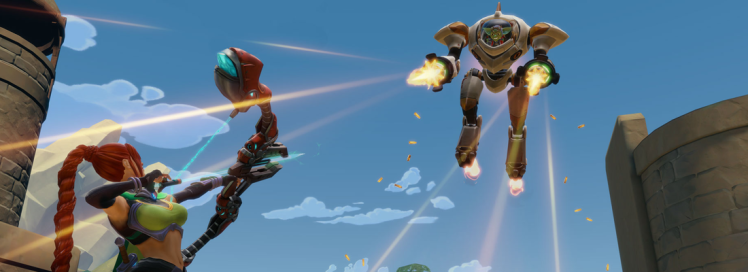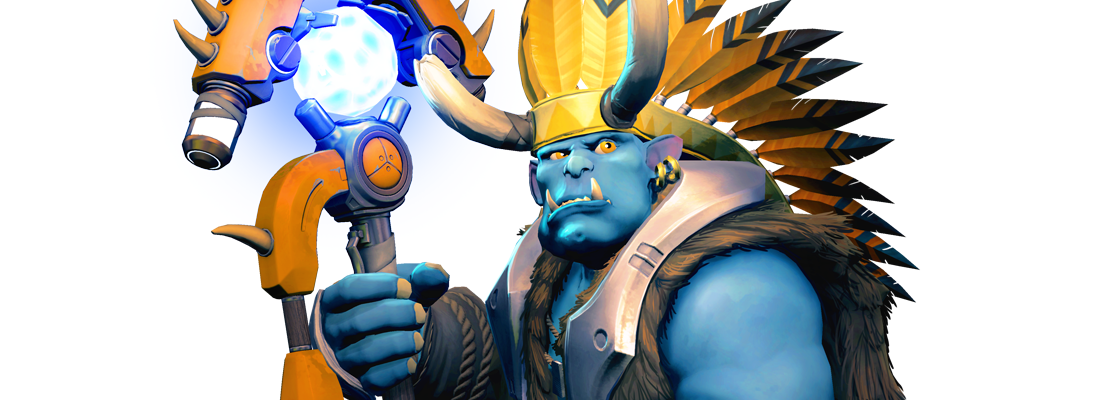While I stood in Hi-Rez Studios’ TwitchCon booth, waiting to play Paladins, I was fortunate enough to be standing next to its lead designer, Rory Newbrough.
Paladins concept is a bit of a beast to design, what with it being a hybrid collectible card game and first-person shooter title. Which also has multiple character types and an odd first-person shooter game mode. The big shocker here, however, is that Newbrough just claimed that an incredibly small number of people are responsible for designing and balancing the entire experience.
I feel I need to push him a bit further on a couple of other details. Here’s part two of our interview.
GamesBeat: How long do matches take?
Rory Newbrough: About 15 to 20 minutes. We want a very condensed experience. We want more bite-sized pieces so someone can sit down and play a 15 minute game and maybe play another one if they have time. Given the right circumstance, you can reach 25, but the goal is 15 to 20.
GamesBeat: Yeah. Fifteen to 20 minutes is about the sweet spot, in my opinion. Just enough time to play a good set, but you’re not committed for a huge chunk of the day.
Newbrough: Long enough to enjoy it, but not so long that you’re tired.
GamesBeat: When you’re designing for the middle ground, pro players want this, and casual players want that. What are some general things you take away from both camps so you wind up in the middle?
Newbrough: For us, the way we look at it is that, basically, we want the +1 of mid [player skill] level. Right? So we want the level of skill where very, very few mistakes are made … like, they’re not professionals killing everyone perfectly, but they’re making very few mistakes. And that is around where we want the game to be played. Right?
It’s an even kilter where if someone is playing the way they’re supposed to, they aren’t doing the greatest in the world and they aren’t playing perfectly, but they know how to make their character work and make all the right decisions for the match. And we kind of balance on that level.
But the big thing for us, you know, before we go and look at camps and who is good at what, we say, “What’s fun? We want the game always fun.”
And that’s what we always look for first. And when we look at something, even if it’s the most balanced thing in the world, if it’s not enjoyable we just throw it out. We’re done with it, because it has to be an enjoyable experience.
But if we look at something [unbalanced] and like it and know it’s fun, then we start looking at it and start analyzing where the problems are going to be [with the unbalanced but fun element] for professional players. What are the problems for the mid-level players. And what is hard to understand for the low-level players. It’s all about being able to understand something and making sure it feels good.
So on the professional level, if we’ve found something that is unbeatable. Counter play is a big piece of competitive games, and if something doesn’t have counter play, then it’s no fun, right?
GamesBeat: Right
Newbrough: So I auto-lock on and hit him instantly. Well … [winces] I can’t dodge that, so … [makes an “enh” face].
GamesBeat: [nods]
Newbrough: It’s why almost no weapons in this game have an instant fire. Almost everything has a travel time. You can move out of the way, you can dodge it.
GamesBeat: Like there’s no Quake III Arena-style Rail Gun or Counter Strike AWP in the design?
Newbrough: Uhm, well, there will be some. Like this guy here, [points to a big troll chieftain character with a staff], he has lightning, and it’s instant, boom, straight shot out. But he’s designed around the fact that he has that. It’s not up front [instant kill] damage.
You’ll see the flamethrower [on another character], even it has build up time before it blooms out.
We really wanted skill shots, dodging, juking … we really love that stuff. We want the top-level players to enjoy it, and the things we look at are, is it dodgeable? Is there counter play? Is there something you can do about it?
And we didn’t want to put anything in the game that, you know, there’s nothing you can do about.
GamesBeat: Right
Newbrough: There’s no fun in that.
GamesBeat: So what games have been an influence for Paladins? Because it looks very arena-like, like Quake and Unreal Tournament in nature.
Newbrough: We’re all big FPS fans, so I’d say the inspiration comes from … believe it or not, Global Agenda. We loved Global Agenda; it was our first game, obviously. So we kind of wanted to make sure we got that gameplay in there.
There’s some inspirations drawn from Team Fortress 2.
We also kind of wanted to get a bit more open space. Like, you mentioned Arena, but we wanted to open up the environment a bit more and give players a lot more open space.
And … it’s an interesting culmination of so many genres, right? You have the strategy from card games. You have the arena style like Quake. You have your team based combat. We’ve blended a lot of things together to create the experience.
I don’t want to say it was directly driven by, well, like we don’t have an internal play test team in the studio. Our playtesters are our devs.
GamesBeat: Really?
Newbrough: Like, I playtest every day. Our CEO playtests every day. Our producer playtests every day. And that’s our playtest group. For us, we don’t like having other people playtest our game because once we play it, we like it, we think it’s fun — then we let other people play it … and for us we’ll wake up one day, think of something new to add and think, “OK, cool! Let’s try it.”
We put it in the game, try it, then decide did we like it? Did we not like it? Can we make it better? And if we still don’t like it, we throw it out.
GamesBeat: Hmmm. …
Newbrough: So for us, we knew we wanted to do a FPS. We knew we wanted arena-style. We knew we wanted strategy in there somewhere. We knew we wanted the bigger maps … and then we just kinda tested things and molded it until we got to the size we wanted.
GamesBeat: You don’t find that dangerous, though? That you guys are the only ones playtesting the game? It’s like, you can be too close to your own work and not see that something isn’t working. Sometimes that’s where you need a fresh pair of eyes … a third perspective or a play test team that’s still somewhat detached from the work.
Newbrough: Right. That’s partially why we bring it to someplace like here [TwitchCon]. We also have professional players that come into the studio and we’re like, “Hey! Come here and play the game.”
We’re very open about allowing people to play the game, try it … and we like feedback.
We want to know if people like it or not. And generally, that game dev playtest style is in early development. Until we get the game locked down. But for us, the second it goes out, we have tons of analytics. We can see what character every player is picking. We talk to professionals and teams that do nothing but collect data while we’re playing the game. We have meetings about, you know, what did people like about it? What did they find frustrating?
So we try to get multiple pillars of players playing. But the tight-knit, dev-only playtesting only happens in the early stages when we’re trying to figure out what the game is going to be.
VentureBeat's mission is to be a digital town square for technical decision-makers to gain knowledge about transformative enterprise technology and transact. Learn More


